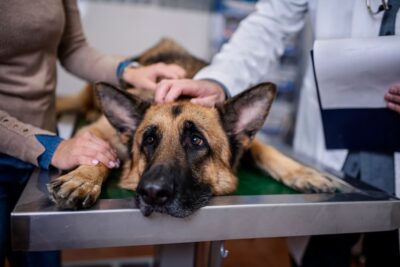How To Tell If Your Dog Has Fleas?

All featured products are chosen at the discretion of the GreatPetCare editorial team and do not reflect a direct endorsement by the author or reviewer.
Fleas are more than unsightly. These bloodsucking parasites are a source of major discomfort for dogs, and left unchecked can damage skin and cause infections. Fleas on dogs are common, and are in fact a leading cause of skin disease.
Therefore, learning to identify fleas before they can cause destruction is a valuable skill, but finding these tiny terrors is tricky. Not only can these parasites move rapidly and without detection, the symptoms they create are similar to those found in diseases not caused by fleas.
Always start a conversation with your veterinarian if you suspect your dog has fleas. To help take the guesswork out of flea identification, we’ve compiled a guide that shows you how to tell if your dog has fleas, how to get rid of them once you do find them, and how to prevent future occurrences with a monthly flea preventative such as Simparica TRIO or Revolution.
Identifying Fleas: The Basics

Once you can identify fleas on your dog, you’re better positioned to provide relief from the itchiness and discomfort, and to prevent health problems—like hot spots and bacterial infections—from occurring.
What Do Fleas Look Like?

Finding fleas on dogs isn’t easy. Not only are these reddish-brown parasites the approximate size of a sesame seed, they have a flattened body that lets them move quickly and stay out of sight. Fleas are wingless insects, so while they can’t fly, they have a long pair of hind legs that gives them athletic-grade jumping abilities. They’re able to maintain a solid grip on dogs because of the rows of comb-like, spiny structures on their legs, back, and mouth.
So how do you look for something so undetectable? It’s easier to look for flea excrement (flea dirt) than actual fleas, veterinarians say. You can accomplish this with a flea comb,” says Dr. Susan O’Bell, service director at Angell Animal Medical Center in Boston.
“This looks like coffee grounds or dirt on the comb as you sift through the fur or hair, especially down the back toward the base of the tail,” she says.
Flea Eggs on Dogs
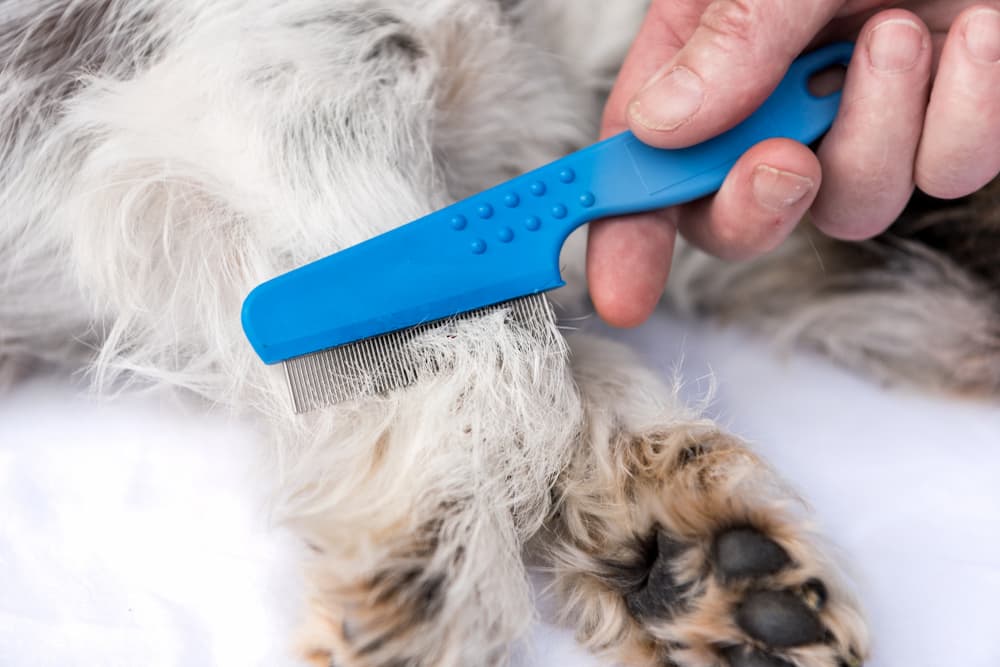
Flea eggs are even more difficult to see than adult fleas. “They are about the size of a grain of salt though oval and off-white in color. They can be on the coat but can be mistaken for dry skin,” says Dr. George Melillo, co-founder and chief veterinary officer at Heart + Paw, headquartered in Philadelphia.
By using a flea comb to gently push the fur away from the skin, you’ll be able to get a closer look, says O’Bell, who is board certified in veterinary internal medicine.
Flea eggs don’t remain on dogs for very long, though. “The majority of flea eggs will fall off a dog shortly after they are laid and, if they fall onto warm carpets, blankets, or bedding, can easily hatch, with subsequent fleas finding their way back to your dog,” O’Bell says.
Flea Bites on Dogs
Flea bites on dogs appear as very small, raised red dots, says O’Bell. “They are usually smaller than other insect bites though they can be easily inflamed, and appear larger, once a dog scratches the itch.”
The size of the bite can vary, however. “Some dogs will have a much stronger itch reaction than others, which often will result in a much larger and more visible red area,” O’Bell adds.
Signs of Fleas on Dogs

Aside from confirming the presence of fleas, flea dirt, or flea eggs on dogs, there are some other signs you can watch for. Since these signs can be present in unrelated conditions, we recommend contacting your veterinarian if you notice anything out of the ordinary.
Scratching and Biting
Excessive scratching or biting at the fur is one of the most common signs of fleas on dogs, says Melillo. “Dogs scratch on occasion just like people do. If the scratching or chewing at the fur becomes unusual, fleas should be considered.”
It doesn’t necessarily take a flea infestation to cause potent itchiness, either. “Some dogs will have hypersensitivity to fleas and one or two fleas will cause intense itchy skin,” adds Melillo.
Skin Wounds or Hair Loss

All that repeated scratching and biting can damage your dog’s skin. “Often, especially with dogs that have flea allergies, the skin could quickly become quite red, raw, and experience fur loss,” says Melillo.
If these hot spots (also called acute moist dermatitis) become inflamed and infected, your veterinarian may prescribe a course of antibiotics and steroids.
Hair loss on the lower back, belly, and thighs can also be a sign of fleas on dogs.
Small Red Spots
Tiny, red, raised spots on the skin are a sign of flea bites on dogs, says Melillo. “They are small and often best seen in areas where the fur is thinner (like on the belly) or at the base of the tail.” Flea bites can also become inflamed and appear larger in some dogs.
The Presence of Flea Dirt

Not to be confused with flea eggs, flea dirt—flea excrement containing the dog’s digested blood—is more commonly found on dogs than live fleas. “If you take some of the flea dirt and place it on a wet paper towel, the flea dirt will appear reddish brown. It is a sign of fleas,” says Melillo.
Pale Gums
Pale pink to white gums are one of several signs of fleas on dogs. Because fleas feast on their host’s blood, a flea infestation can result in significant blood loss, and consequently pale gums. Healthy gums are salmon pink, shiny, and moist. If you notice pale gums and suspect fleas, contact a veterinarian quickly or bring your dog to an emergency hospital for treatment.
Weight Loss
Fleas carry tapeworms, a parasite that grows internally when a dog inadvertently ingests a flea. This usually happens during self-grooming, as the dog attempts to alleviate the itchiness and discomfort. Dogs with tapeworms might experience some unexpected weight loss or diarrhea. You may also notice the presence of tapeworm segments around the anus, which look like sesame seeds.
Does Your Dog Have a Flea Allergy or an Unrelated Skin Condition?

Though flea allergy in dogs is a common cause of skin disease in dogs, there are other conditions—like food allergies, allergies to pollen or mold, dry skin, or fungal infections—that might be the source of your dog’s symptoms. So while looking for the above signs can be helpful, you need to confirm the actual presence of fleas, flea dirt, or flea eggs to be certain.
This is why it’s essential to consult your veterinarian if you suspect your dog has fleas. “The veterinarian will also assess if there is an allergic component to the discomfort or even a secondary bacterial infection that can be a result of fleas,” says Melilo. “Many times a dog will require medications to treat these secondary skin diseases while also tackling the flea problem.”
How to Get Rid of Fleas

In order to get rid of fleas, it’s important to treat your dog—and any other pets in your home—as well as your environment, says Melillo. “If you only treat the dog, without treating the home, you are unlikely to ever resolve the flea problem.”
How to Kill Fleas on Dogs
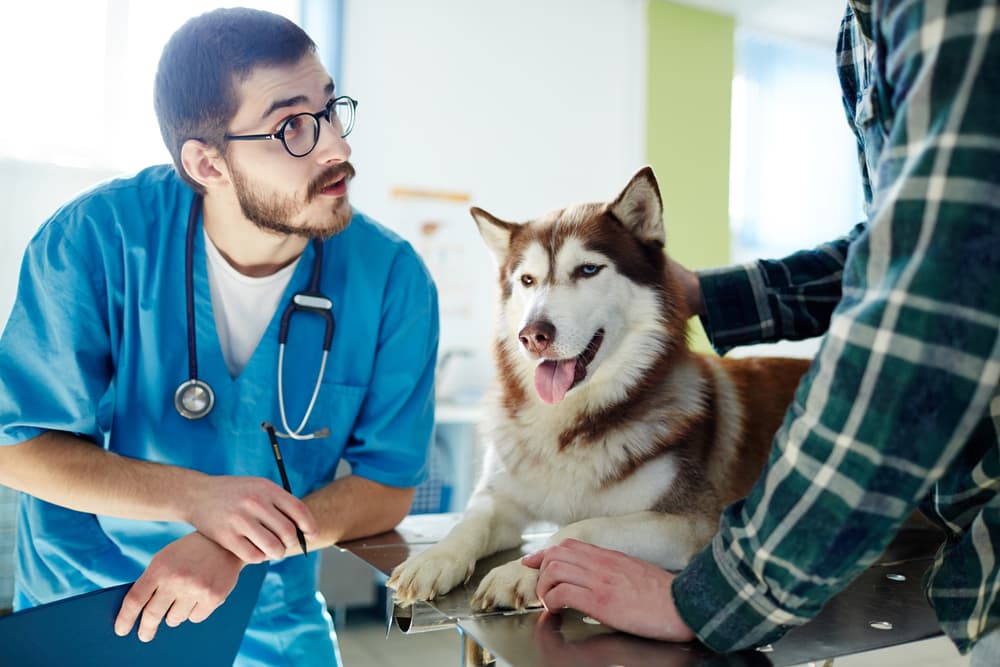
To kill fleas on dogs, start by talking to your veterinarian. “It’s always best to discuss treatment plans with your veterinarian as the best approach will differ according to the individual dog and his or her home environment,” says O’Bell.
Generally, though, if you suspect fleas, the most important thing you can do is to treat your dog and any other pets in your home with a veterinary recommended product, says O’Bell. “These products are, broadly speaking, very safe and highly effective.”
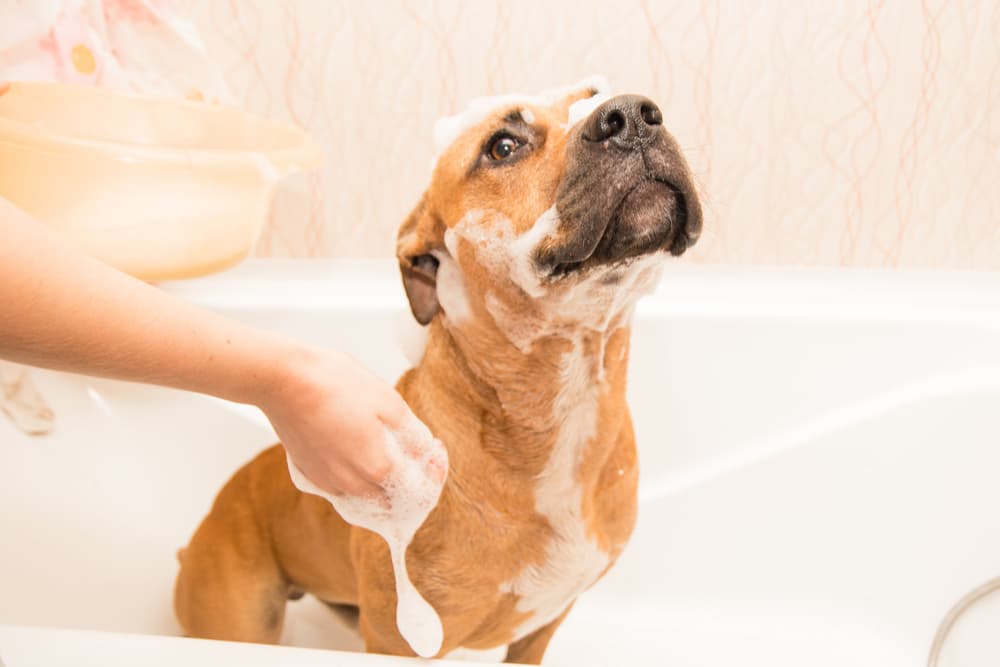
Just keep in mind that killing the fleas on your dog doesn’t necessarily mean your pet is flea-free. Medications like Capstar, which contains the chemical compound nitenpyram, function as a fast-acting insecticide that kills adult fleas. These products will only last for one day, however, so it is important to also use a flea preventive that is long-acting and will kill multiple life stages of fleas, from eggs to adults.
Veterinarians typically suggest a dual attack plan that targets both adult fleas and flea eggs. This could include longer-lasting parasiticides to ensure that any new fleas that jump on your dog in the next 1-3 months are quickly killed. There are also products containing insect growth regulators (IGRs), an insecticide that prevents flea eggs from maturing into adult fleas.
Flea control and preventative products come in a wide range for forms, from collars and sprays to oral and topical medications. However, prescription flea medications are generally much more effective than over-the-counter products. These come in easy-to-apply topical solutions, like Revolution, as well as oral medications, like Simparica TRIO.
Revolution is flea preventative you apply to the skin on your dog’s back once a month. It’s absorbed into your dog’s blood and protects your pet by killing adult fleas and preventing flea eggs from hatching. It also prevents heartworm disease and protects against the American dog tick, ear mites and sarcoptic mange. Simparica TRIO comes in a tasty chewable tablet to make monthly dosing a breeze. It starts killing fleas within 4 hours, before they can lay eggs, and also prevents heartworm disease, protects against five species of ticks (including the species that transmits Lyme disease), and treats roundworms and hookworms.


Ask your veterinarian if giving your dog a lukewarm bath might be beneficial. There are dog shampoos on the market formulated to kill fleas, as well as calm irritated, itchy skin with ingredients like oatmeal.
How to Kill Fleas in the Home

If your dog has a flea infestation, killing the fleas on your dog won’t solve the problem. It’s important to thoroughly clean your home and your dog’s environment. Here are some tips for killing fleas in your home.
Vacuum regularly. Vacuuming has been shown to be effective in eliminating fleas in all life stages, researchers at Ohio State University say. Experts recommend vacuuming every day if possible, or at least every other day. Focus on hidden areas like closets and crevices, as well as open rugs and carpets. Vacuuming “underneath cushions and under pieces of furniture should all be included in your cleaning plan,” says O’Bell.
Use a vacuum with good suction, and toss the canister or bag with the remnants into your trash container (then seal it) to prevent eggs from hatching. Additionally, the U.S. Environmental Protection Agency says the hot steam and soap from a steam cleaner can kill fleas in all stages of their life cycle.

Wash bedding and upholstery. Find bedding, towels, upholstery covers, toys, or any items your dog spends a lot of time with and toss them in the washing machine. Using the hottest cycle possible, wash these items with laundry detergent or bleach, then place them in the dryer. Consider tossing and replacing items if the flea infestation is extreme.
Products with IRG (used to kill flea eggs) are also available in spray form to use on your pet’s bed. Just make sure to follow directions to keep your pet safe.
Discourage pets from sleeping on furniture. It’s best to keep dogs off furniture, at least until you’ve had a chance to eradicate the flea problem, recommends O’Bell. “Eggs that hatch can fall on these surfaces and lead to more generations of fleas in a relatively short period of time.”
How to Prevent Fleas on Dogs

It’s much easier and cheaper to prevent fleas than to eradicate them, especially since fleas reproduce quickly. Here are a few tips that may spare you and your dog aggravation.
Use a Flea Preventative on a Regular Basis
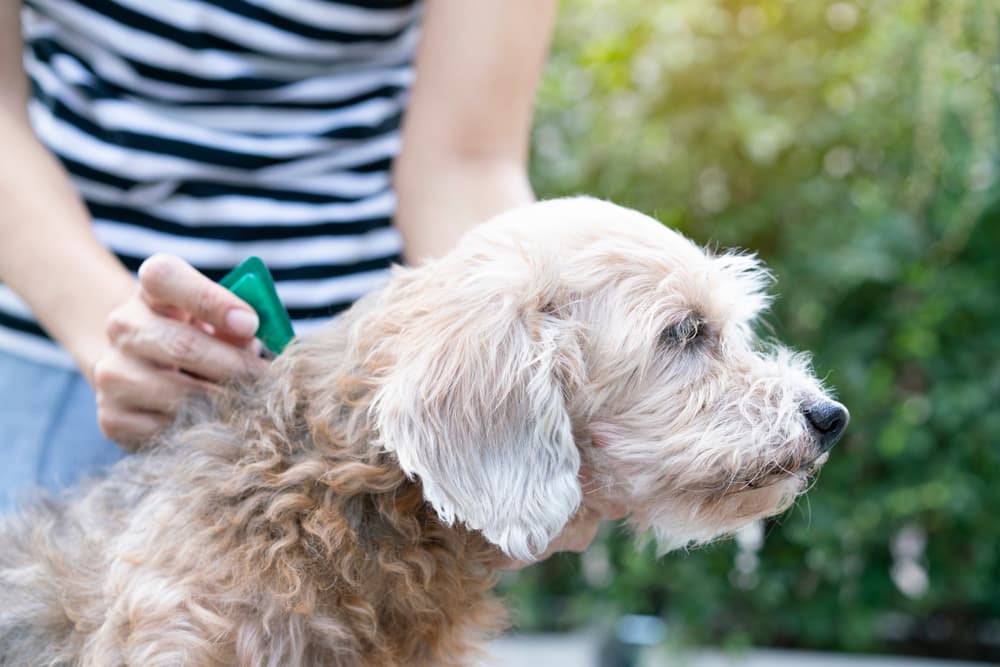
The center of any flea prevention plan is the regular use of a veterinary-recommended preventative product. “Using monthly prevention against fleas is the best way to eliminate flea allergy in the first place,” says O’Bell.
Prescription preventatives are generally the most reliable, says Melillo. These come in the form of oral chews and pills, topicals, and collars. “I tend to recommend oral monthly parasiticides,” he explains. Some dogs that are allergic to oral medications can also use flea collars as a prevention measure. Talk to your veterinarian about the option that is best for your pet.


While some over-the-counter (OTC) products can be effective, Melillo says that fleas can develop resistance to some products. If you do use an OTC product, be sure it’s from a trustworthy source. “I have seen counterfeit products my clients obtained online. Astute veterinary technicians found misinformation on what appeared to be otherwise a replica of a product label,” warns O’Bell.
Whether you use a prescription or OTC preventative, the bottom line is to use a product that has been recommended by your veterinarian.
Develop a Grooming Routine With Your Dog

Using your flea comb, sift through your dog’s hair or fur to find fleas, flea dirt, or flea eggs. If you’re not up to the task, find a professional pet groomer you can take your dog to on a regular basis. These pros are trained to find fleas, and are a good alternative if you don’t know how to tell if your dog has fleas.
Keep It Clean
The same practices used to kill fleas—vacuuming regularly and cleaning bedding—also help to prevent and control them. Fleas don’t just live indoors, however. Since wild animals like raccoons, coyotes, and stray cats can also carry fleas, veterinarians recommend limiting your dog’s contact with them. Or consider humane wildlife deterrents, like installing fencing or placing netting on food plants.
Safety Precautions When Using Flea Products
Check with your veterinarian before using any products containing pesticides since they can interfere with certain medications.
Also avoid using dog flea products on cats, veterinarians warn. The pesticide class pyrethrins, for example, is highly toxic to cats.
“Similarly if you have any exotic species in the house who interact with your cats and dogs, check with your veterinarian as some exotic species can be uniquely sensitive to certain ingredients,” says O’Bell.
